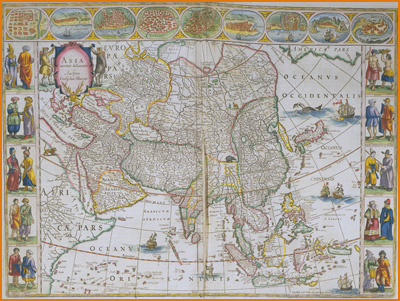|
 |
|
| Photographic Services & Permissions |
 |
|
 Mapping
Muslim Kingdoms Mapping
Muslim Kingdoms
|
Joan Blaeu (1596–1673)
Grooten atlas, oft Werelt beschryving [The Great Atlas,
or, A Description of the World]
Amsterdam, 1648–64
NYPL, Map Division
This Dutch map of the Asian continent, centered on West Asia, suggests the exoticism
of these regions, as well as neighboring Muscovite Russia. Central Asia is typified
by a camel; India by an elephant. Square-rigged galleons sail the Indian Ocean
and the Arabian Sea; a whale spouts at top right. The outer margins present vividly
hand-colored costume drawings of “Muscovites,” “Tatars,” and others.

|
|














